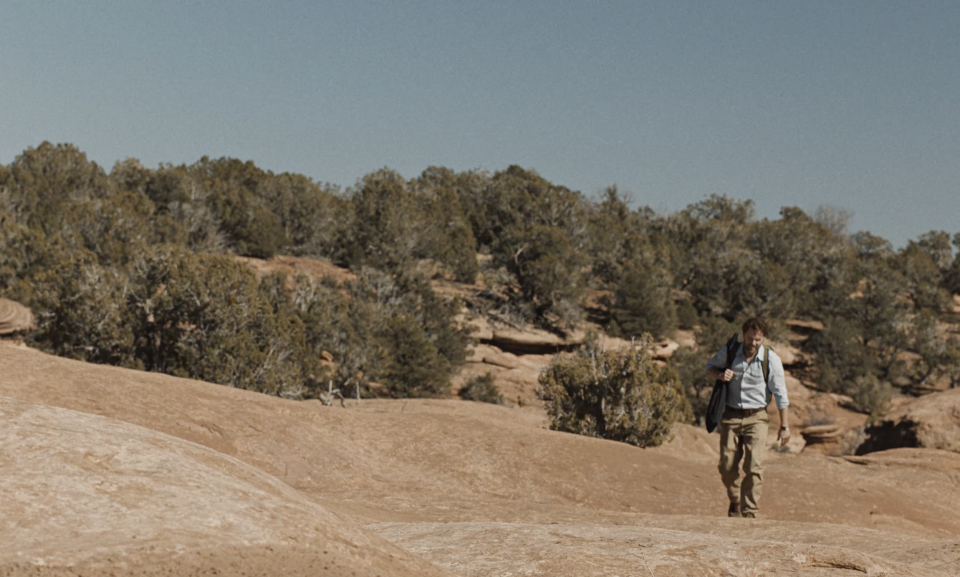‘The Seeding’ Review: Kate Lyn Sheil Delivers in Atmospheric Horror About a Hole

- Oops!Something went wrong.Please try again later.
- Oops!Something went wrong.Please try again later.
- Oops!Something went wrong.Please try again later.
A half hour into Barnaby Clay’s debut narrative feature, “The Seeding,” Scott Haze drops to his knees and begs, “Will someone just tell me WHAT is going on?” It’s an uncharacteristically funny beat coming from a character deadass named Wyndham Stone, a photographer who explicitly shops at Brooks Brothers and boasts all the personality of half-off wrinkle guard. But the unintentionally self-aware line is an early pop of entertainment in this otherwise maddening experiment in atmospheric dread. “What IS going on?” you’ll wonder ad nauseam — only to be forced-fed an answer less satisfying than a hunk of moldy bread. At least the table setting works.
Shot in a rust-red canyon in Utah, this meditation on domestic despair begins with an arresting image; a young child, no more than two-years-old, toddles through the desert alone munching on a human finger. It’s a stomach-churning cold open for the elevated “Wrong Turn” redux that intrigues and intimidates; not to mention, the nature cinematography is stunning enough to bring the narration of David Attenborough to mind. (“Here, we meet the mystery cannibal child in their native habitat: a punishing desert for work and for play…”)
More from IndieWire
Cut to Wyndham, who is taking pictures alone when he stumbles on a different kid (Charlie Avink). Maybe 11 or 12, he’s also been inexplicably separated from his parents and pleads for help. But when Wyndham follows the uncooperative boy (the script probably didn’t have to arm the child actor with the word “f*ggot,” but OK) into the barren landscape, our clean-cut nice guy falls into a puzzling trap that’s simple but sinister.
Chasing the walking CPS case into a steep chasm, Wyndham comes on a house occupied by a near-silent woman named Alina. Delivering the same steely strangeness on display in “She Dies Tomorrow,” Kate Lyn Sheil crafts a delicate performance. Perched on the ledge between survival and supernatural horror, she’s a kind of weathervane for the mutating movie’s slippery subgenre. Offering Wyndham a place to sleep before he even realizes he’s in a cage, the bewitching stranger feels almost transported from another universe. Is she friend? Foe? Both?

It’s not until the ladder that led Wyndham down there disappears — and he’s met with a fate typically reserved for the single-celled organisms of “The Sims” games — that the reality of their predicament sinks in. Man and de facto wife, they’re stuck in a hole doubling as a ham-fisted symbol for procreation and the Garden of Eden from Hell. The edge is guarded by a troupe of feral boys; the bait is among them, and the games have just begun.
Led by a theatrical ringleader (Alex Montaldo) whose more Logan Huntzberger than Alex DeLarge*, the misfit villains torture Wyndham while Alina keeps her head down. *(“Gilmore Girls” and “A Clockwork Orange” are easier texts to compare than you’d think!) The basic supplies are inexplicably provided with a steady stream of food and water. And the passage of time is marked in title cards, with yet another variation on the “Saltburn” font heralding different phases of the Moon. Inside this self-contained ecosystem, frequently shot top-down and complete with a fictional language shared by Alina and the captors, a life cycle looms.
Gorgeous with grand ambitions, but ultimately as pedestrian as any other half-baked hillbilly horror, Clay’s meandering metaphor for fatherhood isn’t so much moving or scary as it is weakly disconcerting. The story, crafted by a filmmaker primarily known for documentaries and music videos, prioritizes vibes above emotional logic and buries its brutal violence with stylistic choices that feel amateurish. It’s a hallmark of cult horror to include murals dropping hints about the plot (see “Midsommar”), and jagged slow-motion sequences can add great texture to rural terror (see “Texas Chainsaw Massacre”). But the filmmaker’s choices war against each other here, making for an uneven watch that grows more predictable as its cliches progress.

With a day-and-date release, “The Seeding” might be better enjoyed on the big screen. Its visual scope would certainly play better in a theater than on a laptop, and its existential themes could benefit just as much; waxing poetic on the helplessness of fatherhood is just better in an AMC. Still, the mixed mulch bag of a movie is ultimately a disappointment in construction and conceit — a putrid desert flower that never fully blooms.
Grade: C-
A Magnet release, “The Seeding” hits theaters and VOD Friday, January 26.
Best of IndieWire
Sign up for Indiewire's Newsletter. For the latest news, follow us on Facebook, Twitter, and Instagram.

